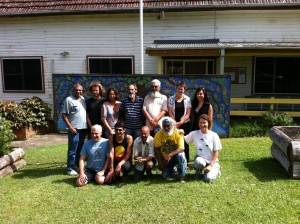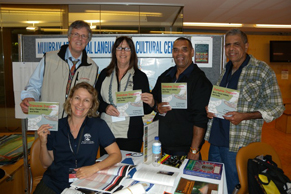
On Wednesday, December 12, 2012, Gathang community members gathered to celebrate the launch of a new web portal dedicated to the revitalization of their Indigenous language. Media were invited to attend the event, which took place at 2 p.m. in Room AG 03 in the General Education building at Taree TAFE, Montgomery Crescent.
The first of its kind in Australia, the Gathang portal includes a dictionary archive, images and audio, allowing learners to go online and listen to their language – anywhere, anytime! Additional pictures and audio will be uploaded in the coming months, and in time language games and activities will be added. Please visit www.firstvoices.com/en/Gathang to see what has been achieved.
Made up of the Birrbay, Warrimay and Guringay peoples, Gathang speakers cover a large part of coastal New South Wales from Port Stephens to Port Macquarie. “We have a limited number of fluent speakers,” says Gathang language administrator and community member Jeremy Saunders. “Having the portal will engage young people in language learning, as well as give those living away from home the chance to enhance their language knowledge.”
The portal is the result of a collaborative effort between two Indigenous organisations from opposite sides of the Pacific Ocean:
FirstVoices, a program of the First Peoples’ Cultural Council (FPCC) is based in British Columbia, Canada. The FirstVoices suite of web-based tools and services support Aboriginal people engaged in language archiving, teaching and revitalization. Launched in 2003, FirstVoices has worked with over 60 languages from Canada and the U.S.A.

Muurrbay is a Regional Aboriginal Language Centre that supports Aboriginal people on the east coast of Australia to revive their language and culture. Based on Gumbaynggirr country, Muurrbay initially focused on Gumbaynggirr language reclamation. Through their regional wing, Many Rivers Aboriginal Language Centre, established in 2004, they support another six languages, including Gathang by documenting languages, publishing language resources and developing courses for adults.
FirstVoices co-visionary and manager Peter Brand first met Anna Ash, regional co-ordinator with Many Rivers, at Puliima, a national Aboriginal languages conference held in Brisbane in 2010. Following much discussion and community consultation, FirstVoices and Muurrbay agreed to run a pilot project, the first of its kind in Australia, whereby the Gathang language database that was the basis of the published dictionary would be uploaded to the FirstVoices web hub. A Gumbaynggirr project will follow in 2013.
Peter, an Australian expat, has traveled from his home in Canada to attend the community’s official launch of the new website. “I’m extremely excited to see Muurrbay break ground in this area. It’s daunting for Aboriginal communities to put their languages on the web, but in our experience, making use of the latest technologies can greatly support the language work that goes on within the communities, and the fear of appropriation is not warranted.” Peter will be visiting several locations in Australia in December and January to encourage and assist other communities to participate in FirstVoices.
“Muurrbay has published several dictionary-grammars, which is an important first step, but people say that they want to hear their language,” says Anna Ash. “This online archive will make all the difference to revitalizing the language. The hard work and dedication of the Gathang language recorders has made this a reality.” Anna is referring to Jeremy Saunders and language recorders Mandy Davis, Marcus Rowsell and Jim and Tony Ridgeway, who were trained by FirstVoices in December last year and have been adding audio and visual resources all year.
Muurrbay gratefully acknowledges funding from the Australian Government’s Department of Regional Australia, Local Government, Arts and Sport via its Indigenous Languages Support (ILS) program.